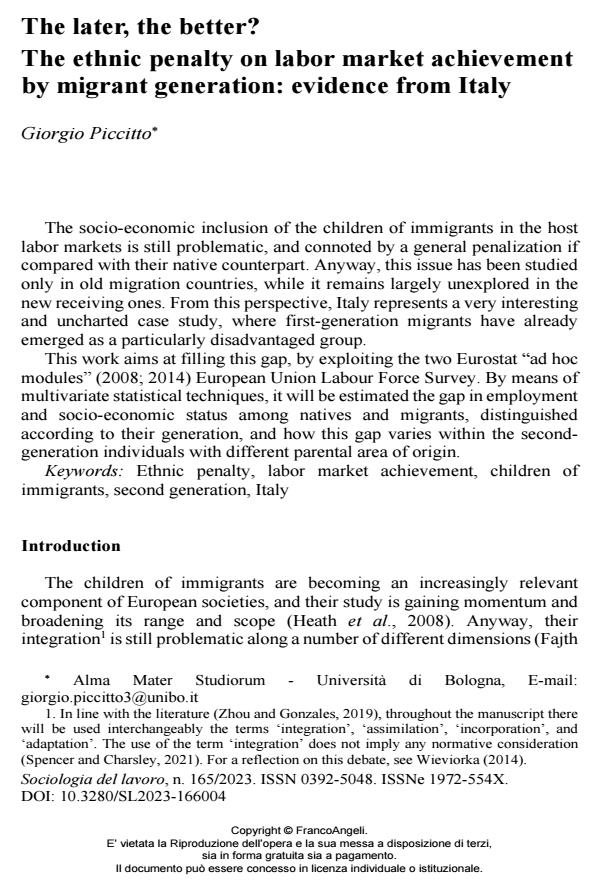The later, the better? The ethnic penalty on labor market achievement by migrant generation: evidence from Italy
Titolo Rivista SOCIOLOGIA DEL LAVORO
Autori/Curatori Giorgio Piccitto
Anno di pubblicazione 2023 Fascicolo 2023/166
Lingua Inglese Numero pagine 23 P. 79-101 Dimensione file 315 KB
DOI 10.3280/SL2023-166004
Il DOI è il codice a barre della proprietà intellettuale: per saperne di più
clicca qui
Qui sotto puoi vedere in anteprima la prima pagina di questo articolo.
Se questo articolo ti interessa, lo puoi acquistare (e scaricare in formato pdf) seguendo le facili indicazioni per acquistare il download credit. Acquista Download Credits per scaricare questo Articolo in formato PDF

FrancoAngeli è membro della Publishers International Linking Association, Inc (PILA)associazione indipendente e non profit per facilitare (attraverso i servizi tecnologici implementati da CrossRef.org) l’accesso degli studiosi ai contenuti digitali nelle pubblicazioni professionali e scientifiche
The socio-economic inclusion of the children of immigrants in the host labor markets is still problematic, and connoted by a general penalization if compared with their native counterpart. Anyway, this issue has been studied only in old migration countries, while it remains largely unexplored in the new receiving ones. From this perspective, Italy represents a very interesting and uncharted case study, where first-generation migrants have already emerged as a particularly disadvantaged group. This work aims at filling this gap, by exploiting the two Eurostat “ad hoc modules” (2008; 2014) European Union Labour Force Survey. By means of multivariate statistical techniques, it will be estimated the gap in employment and socio-economic status among natives and migrants, distinguished according to their generation, and how this gap varies within the second-generation individuals with different parental area of origin.
Parole chiave:Ethnic penalty, labor market achievement, children of immigrants, second generation, Italy
- Are there equal opportunities? A comparative analysis of first employment among young adults with and without migratory background in Italy Alessandra Di Bello, Alessia De Vito, Alessia Acito, in Rivista Italiana di Economia Demografia e Statistica /2025 pp.115
DOI: 10.71014/sieds.v79i2.361 - Labour Market Participation of Second-Generation Youth In Italy Ivana Fellini, Francesca Megna, in Rivista Italiana di Economia Demografia e Statistica /2024 pp.147
DOI: 10.71014/sieds.v78i3.289 - Methodological and Applied Statistics and Demography IV Giorgio Piccitto, pp.422 (ISBN:978-3-031-64446-7)
- Migrants' descendants in Italy: experiences and representations in the research. A literature review Stefano Allievi, Sveva Magaraggia, Daniela Cherubini, Andrea Calabretta, Alessandra Turchetti, Enrico Maria La Forgia, in MONDI MIGRANTI 3/2025 pp.166
DOI: 10.3280/MM2025-003008
Giorgio Piccitto, The later, the better? The ethnic penalty on labor market achievement by migrant generation: evidence from Italy in "SOCIOLOGIA DEL LAVORO " 166/2023, pp 79-101, DOI: 10.3280/SL2023-166004